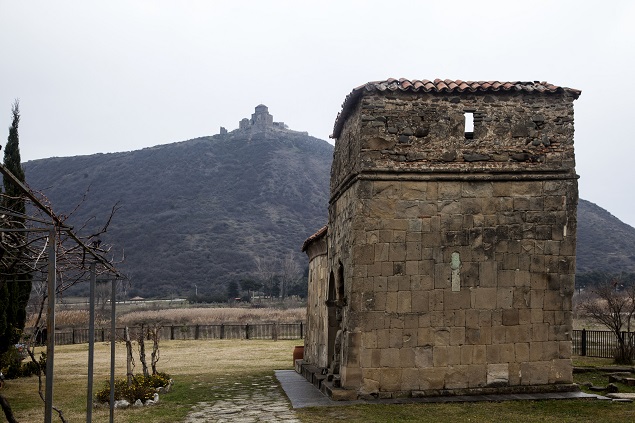Mtskheta could return to UNESCO World Heritage List in 2016

Georgia’s historical monuments of Mtskheta have been given another chance to return to the UNESCO World Heritage List after being relegated to the List of World Heritage in Danger in 2009.
UNESCO, the United Nations educational, scientific and cultural organisation, discussed the issue at its 39th session in Germany and decided to give Georgia a year to meet all the criteria. If everything is done as outlined by the organisation, Mtskheta will return to the main list in 2016.

An ancient church in Mtskheta and Jvari Monastery on the background. Photo by Nino Alavidze/Agenda.ge.
Mtkheta is one of the world’s oldest continuously inhabited cities and is located 20 kilometres north of Tbilisi. Historical monuments within the ancient city were listed among UNESCO World Heritage Sites until 2009 when they were inscribed on the List of World Heritage in Danger because of concerns over their preservation.

Svetitskhoveli Cathedral in Mtskheta. Photo by A. Muhranoff.
At that time UNESCO asked Georgia to adopt an integrated management plan for the sites and address problems related to the "serious deterioration” of the stonework and frescoes. Other issues of concern included the management of land near the churches and loss of authenticity due to work carried out in the buildings, inscribed on UNESCO’s World Heritage List in 1994.
At its latest session last week, UNESCO officials listened to Georgia’s Culture Minister Mikheil Giorgadze, who said all new constructions had been stopped in the area and the country had a plan to properly preserve the city and its historical monuments.
UNESCO gave Georgia detailed instructions on what could not be built in specific areas of Mstkheta and promised the country if everything went as planned, the ancient city would regain its status of World Heritage Site.
Meanwhile a similar situation currently surrounds another monument in western Georgia. In 2016 UNESCO must decide the fate of Gelati church in Kutaisi.

Gelati. Photo by G. Chanadiri.
Two churches in Kutaisi, Gelati and Bagrati, had been listed on the UNESCO World Heritage List as one joint nomination for years. The churches were inscribed on the Danger list in 2010 after Georgian authorities reconstructed Bagrati in a way that was not approved by UNESCO. Since the two churches presented one nomination, Gelati was also affected by Bagrati’s removal from the main list.
Now Georgian authorities must separate the nomination and present Gelati and Bagrati to UNESCO as two separate monuments. After this Gelati could return to the main list while Bagrati will remain among the World Heritage Sites in Danger.
The issue will finally be decided in 2016.
 Tweet
Tweet  Share
Share